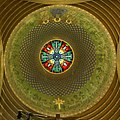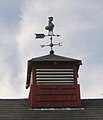Cupola
In architecture, a cupola /ˈkjuːpələ/ is a small, most often dome-like, structure on top of a building.[1] Often used to provide a lookout or to admit light and air, it usually crowns a larger roof or dome.[2][3]
The word derives, via Italian, from the lower Latin cupula (classical Latin cupella from the Greek κύπελλον kupellon) "small cup" (Latin cupa) indicating a vault resembling an upside down cup.[4]
-
Cupolas on the towers of Montefiascone Cathedral, Italy.
-
Ribbed cupola crowns the minaret of the Mosque of Uqba, in Kairouan, Tunisia.
-
Cupolas were also used on some old barns for ventilation.
-
A cupola-style caboose with an angel seat above
Cupolas often appear as small buildings in their own right. They often serve as a lantern, belfry, or belvedere above a main roof. In other cases they may crown a tower, spire, or turret.[3] The chhatri, seen in Indian architecture, fits the definition of a cupola when it is used atop a larger structure.
The cupola is a development during the Renaissance of the oculus, an ancient device found in Roman architecture, but being weatherproof was superior for the wetter climates of northern Europe.
The square dome-like segment of a North American railroad train caboose is also called a cupola. The cupola is used on barns as a vent for heat and moisture.
See also
References
- ^ "Glossary of Architectural Terms - C". Archiseek: Online Architecture Resources. Retrieved 3 January 2009.
- ^ "cupola". The American Heritage Dictionary of the English Language: Fourth Edition. Dictionary.com. 2010. Retrieved 17 March 2010.
- ^ a b "Just what is a cupola anyway?". Cupola Consulting. Retrieved 3 January 2009.
- ^ In Italian cupola simply means dome, and the ornamental top element is called lanterna.






